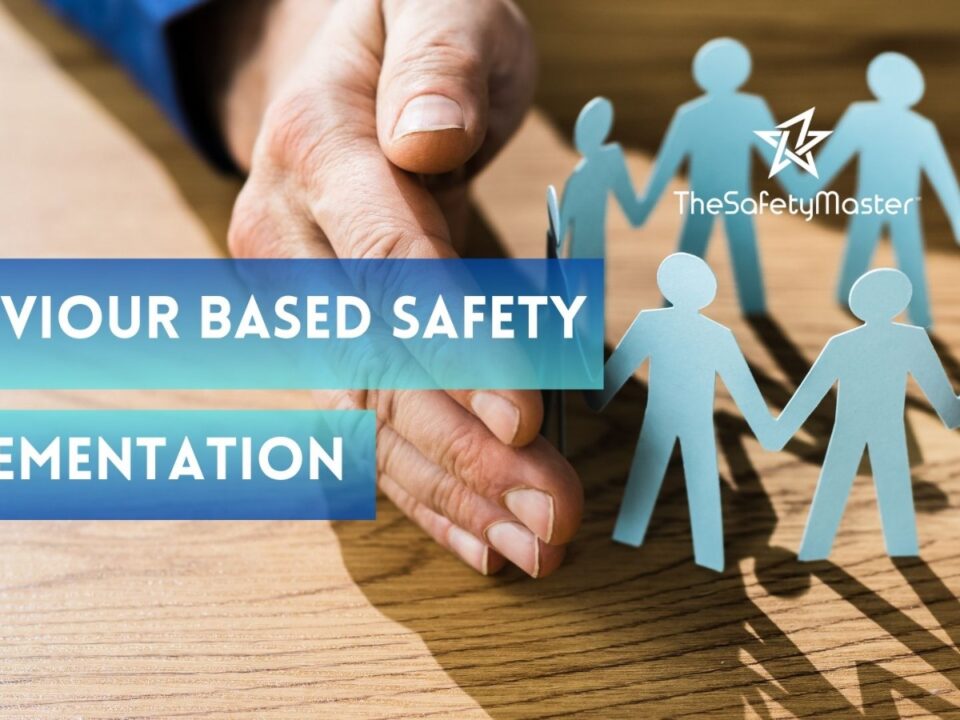Beyond Compliance: Why Manufacturing Industries Should Embrace Behaviour-Based Safety Implementation Programs

Leveraging Technology for Enhanced Job Safety Analysis & Common Mistakes to Avoid in Job Safety Analysis
February 18, 2025
Maximizing Safety Performance: How Behaviour-Based Safety Implementation Can Drive Results
February 21, 2025In this article, we delve into a crucial topic that demands attention from the manufacturing industry: behaviour-based safety implementation programs. Beyond mere compliance with safety regulations, these programs hold the key to transforming workplace safety culture and empowering organizations to proactively mitigate risks. Prepare to gain valuable insights into the challenges faced by manufacturing industries, the potential benefits of embracing behaviour-based safety programs, and practical steps to implement these initiatives effectively. By the end of this article, you will be equipped with the knowledge needed to take manufacturing safety to the next level, ensuring a secure and productive future.
Introduction
In the fast-paced and complex world of manufacturing industries, ensuring the safety of workers and preventing accidents is of utmost importance. However, traditional compliance-based safety programs often fall short in truly fostering a culture of safety. This article explores a transformative approach known as Behaviour-Based Safety (BBS) implementation programs, which have proven to be more effective in reducing incidents and creating a safer work environment. As you delve into this article, expect to gain a deeper understanding of the limitations inherent in compliance-based safety programs. We will explore the benefits that behaviour-based approaches offer and delve into key elements necessary for successful implementation. By embracing BBS programs, manufacturing industries can unlock the full potential of their workforce and create a workplace where safety is not just a checkbox but an intrinsic part of their organizational DNA
Understanding Behaviour-Based Safety
Behaviour-Based Safety (BBS) is a proactive approach to ensuring workplace safety by focusing on the behaviours and actions of individuals within an organization. Unlike traditional compliance-based safety programs, which primarily rely on rules and regulations, BBS takes into account the human element of safety. It recognizes that people’s actions and decisions play a vital role in creating a safe work environment. At its core, BBS aims to identify and address unsafe behaviours before accidents or incidents occur. It involves observing employee behaviour, analysing the root causes of unsafe acts, and implementing interventions that promote safer practices. By understanding why individuals engage in unsafe behaviour, organizations can develop effective strategies to prevent incidents and foster a culture of safety.
Implementing BBS requires a shift in mind set from simply enforcing compliance to actively promoting safe behaviours. It encourages open communication between employees and management, empowering workers to take ownership of their own safety and the safety of their colleagues. This approach not only reduces injuries but also enhances overall productivity and job satisfaction within the manufacturing industry. Embracing BBS is an investment in both the well-being of employees and the long-term success of organizations.
The Importance of Safety in Manufacturing Industries
Safety is the bedrock of any manufacturing industry, as it not only protects the well-being of employees but also ensures the smooth operation of the entire organization. The importance of safety in manufacturing cannot be overstated, for it underpins productivity, efficiency, and ultimately, profitability. When employees feel safe and secure in their working environment, they are more likely to perform optimally and with a sense of purpose. Manufacturing industries often involve complex machinery, hazardous materials, and high-risk processes. Without proper safety measures in place, accidents can occur resulting in injuries or even fatalities. Moreover, these incidents can lead to costly lawsuits and damage a company’s reputation. By prioritizing safety, manufacturing industries communicate a strong message to their workforce that their well-being is valued above all else.
Safety is not just about compliance with regulations; it encompasses a comprehensive approach that goes beyond merely meeting legal requirements. Manufacturing industries should aspire to create a culture where safety is ingrained into every aspect of operations. This involves promoting awareness among employees through training programs and fostering an environment where they feel comfortable reporting potential hazards or near misses.
By investing in safety initiatives, manufacturing industries demonstrate their commitment to employee welfare and set themselves apart as responsible corporate citizens. This proactive approach also has tangible benefits such as reduced downtime due to accidents or injuries, improved employee morale leading to higher retention rates, and enhanced overall productivity.
In conclusion, the significance of safety in manufacturing industries cannot be emphasized enough. It serves as the foundation for success by ensuring employee well-being while maximizing operational efficiency. By embracing behaviour-based safety implementation programs that go beyond compliance-driven approaches, companies can create an environment where each individual takes ownership of their own safety as well as that of others
Common Challenges in Ensuring Safety Compliance
Common Challenges in Ensuring Safety Compliance: In the realm of manufacturing industries, ensuring safety compliance is a paramount concern. However, numerous challenges arise when striving to maintain a safe working environment. One such challenge is the lack of employee engagement and buy-in towards safety protocols. Often, workers may view safety measures as tedious or time-consuming, failing to recognize the long-term benefits they provide.
Another hurdle lies in the dynamic nature of manufacturing processes. With ever-evolving technology and equipment, it becomes increasingly challenging to keep up with the changing safety requirements. This can lead to gaps in knowledge and understanding among employees, ultimately jeopardizing their well-being.
Moreover, resource constraints pose a significant challenge for many organizations. Limited budgets and manpower may hinder the implementation of comprehensive safety programs. Inadequate training and insufficient resources can result in subpar safety measures that do not adequately protect employees from potential hazards.
Despite these challenges, it is crucial for manufacturing industries to tackle them head-on in order to create safer work environments. By addressing employee engagement, adapting to technological advancements, and allocating resources effectively, these industries can overcome obstacles and ensure compliance with safety regulations while fostering a culture of well-being for their workforce.
The Limitations of Traditional Compliance-based Safety Programs
Traditional compliance-based safety programs have long been the cornerstone of many manufacturing industries. These programs focus primarily on ensuring that employees adhere to established safety rules and regulations. While compliance is undoubtedly important, these programs have significant limitations that prevent them from fully ensuring workplace safety. One of the main limitations of traditional compliance-based safety programs is their reactive nature. They rely heavily on identifying violations after they occur and taking corrective actions accordingly. This approach fails to address the root causes of unsafe behaviours, leading to a repetitive cycle of incidents. It also places a heavy burden on supervisors and managers who are tasked with monitoring compliance and enforcing penalties.
Another limitation lies in the lack of employee engagement and empowerment within traditional compliance-based safety programs. Employees often perceive these programs as mere box-ticking exercises rather than opportunities for personal growth and development. Without actively involving employees in shaping safety protocols and recognizing their contributions, organizations miss out on harnessing their valuable insights and commitment to creating a safer work environment.
To overcome these limitations, manufacturing industries should embrace behaviour-based safety implementation programs that prioritize proactive measures over reactive ones. By focusing on understanding the underlying behaviours driving accidents or near-misses, these programs encourage employees to take ownership of their own safety as well as that of their colleagues. This shift in mind set fosters a culture where continuous improvement becomes second nature, ultimately leading to safer workplaces with reduced incidents.
In conclusion, while traditional compliance-based safety programs serve an essential role in maintaining minimum standards, they fall short in cultivating a truly safe working environment. By embracing behaviour-based safety implementation programs, manufacturing industries can transcend mere compliance requirements and proactively address unsafe behaviours at their core
Benefits of Implementing Behaviour-Based Safety
Implementing behavior-based safety programs in manufacturing industries brings a multitude of benefits. Firstly, it shifts the focus from mere compliance to a proactive approach that nurtures a culture of safety consciousness among employees. By encouraging workers to take personal responsibility for their own safety and the safety of others, behaviour-based safety programs empower individuals to identify potential hazards and mitigate risks. Moreover, these programs foster improved communication and collaboration within the workplace. Through regular observation and feedback sessions, employees develop stronger bonds with their peers, supervisors, and management as they actively participate in the continuous improvement of safety practices. This inclusive approach not only enhances morale but also creates a sense of shared responsibility for maintaining a safe working environment.
Additionally, implementing behaviour-based safety programs leads to increased productivity and efficiency. By focusing on identifying root causes rather than simply addressing surface-level issues, organizations can identify underlying factors that contribute to accidents or near-misses. This enables targeted interventions that address behavioural patterns or environmental factors that may hinder productivity, resulting in reduced downtime and improved overall performance. Ultimately, embracing behaviour-based safety implementation programs creates safer workplaces while simultaneously driving organizational success.
Key Elements of an Effective Behaviour-Based Safety Program
Key Elements of an Effective Behaviour-Based Safety Program:1. Leadership Commitment: The foundation of any successful behaviour-based safety program lies in the unwavering commitment and active involvement of organizational leaders. When leaders prioritize safety and demonstrate their dedication to cultivating a safe work environment, it sets the tone for the entire workforce. A leader’s genuine concern for the well-being of employees fosters trust and encourages individuals to embrace safety as a shared responsibility.
Employee Engagement: Engaging employees at all levels is essential in creating a culture that values safety. This involves providing comprehensive training programs that not only educate employees about potential hazards but also empower them to actively participate in identifying and mitigating risks. Encouraging open lines of communication and soliciting feedback from workers ensures their voices are heard, leading to continuous improvement in safety practices.
Behavioural Observation and Feedback: To truly transform safety practices, behaviour-based programs emphasize the importance of observing and providing feedback on employees’ actions. This involves implementing systematic processes where trained observers can identify both safe behaviours that should be reinforced and unsafe behaviours that require corrective action. Constructive feedback serves as a catalyst for positive behavioural change while reinforcing a sense of accountability within the workforce.
By incorporating these key elements into their behaviour-based safety programs, manufacturing industries can create an environment where safe practices become ingrained in daily operations. Such programs go beyond mere compliance with regulations; they empower employees to take ownership of their own safety while fostering a sense of collective responsibility throughout the organization, ultimately leading to improved work conditions and enhanced productivity.
Enhancing Safety Culture through Behavioural Change
Enhancing Safety Culture through Behavioural Change: In order to create a sustainable culture of safety within manufacturing industries, it is imperative to focus on behavioural change. By instilling the understanding that safety is not just a set of rules, but a way of life, employees can develop a deep-rooted commitment to safe practices. This requires a shift in mind set from mere compliance to active participation in shaping a safe work environment. It calls for fostering an atmosphere where individuals take personal responsibility for their actions and look out for the well-being of their colleagues.
Encouraging behavioural change starts with effective communication. Management should clearly articulate the importance of safety and provide regular updates on its progress. Through open dialogue and feedback channels, employees should be empowered to voice concerns or suggest improvements without fear of retribution. Moreover, training programs can play a pivotal role in educating employees about potential hazards and teaching them practical skills that enable them to make informed decisions when faced with risky situations.
To further promote behavioural change, positive reinforcement mechanisms can be implemented. Recognizing and rewarding individuals who consistently prioritize safety encourages others to adopt similar habits. This could take the form of public acknowledgments, monetary incentives, or even non-monetary gestures like certificates or tokens of appreciation. By celebrating acts that prioritize safety, organizations reinforce the idea that going above and beyond basic compliance is not just commendable but essential.
By placing emphasis on behavioural change rather than rigid adherence to regulations alone, manufacturing industries have an opportunity to foster profound shifts in their safety culture. When individuals understand that they hold the power to protect themselves and their colleagues through conscious actions, they become agents of positive change within their workplace environment
Overcoming Resistance to Change in the Workplace
Overcoming Resistance to Change in the Workplace: In the realm of workplace safety, implementing behaviour-based programs often faces resistance from employees who are wary of change. It is crucial for organizations to address this resistance head-on and foster a culture that embraces new initiatives. To achieve this, open lines of communication must be established, allowing employees to voice their concerns and participate actively in the decision-making process.
One effective strategy is to provide comprehensive training and education on the benefits of behaviour-based safety programs. By empowering employees with knowledge about how these programs can improve their own well-being, as well as the overall success of the organization, they are more likely to embrace change with enthusiasm. Additionally, highlighting success stories from other industries or teams within the organization can help create a positive narrative around adopting behaviour-based safety practices.
Furthermore, leadership plays a pivotal role in overcoming resistance to change. Managers and supervisors should lead by example by visibly supporting and participating in behaviour-based safety initiatives. By consistently demonstrating their commitment to employee welfare, leaders can inspire confidence and encourage employees at all levels to actively engage in these transformative programs. Ultimately, fostering an environment of trust and collaboration will pave the way for successful implementation while minimizing resistance along the journey towards improved workplace safety.
Strategies for Successful Implementation of Behaviour-Based Safety Programs
Strategies for Successful Implementation of Behaviour-Based Safety Programs: To ensure the successful implementation of behaviour-based safety programs, manufacturing industries must adopt a multifaceted approach that combines education, engagement, and continuous improvement. First and foremost, fostering open communication channels between management and employees is crucial. By encouraging dialogue and active participation, workers feel valued and motivated to contribute to a safer work environment.
Furthermore, establishing clear goals and objectives is essential for driving behavioural change. This can be achieved through the development of comprehensive safety policies that outline specific behaviours and practices expected from employees. By providing employees with a roadmap for success, it becomes easier to align their actions with the desired safety outcomes.
Another effective strategy is to promote accountability at all levels of the organization. By holding both management and employees responsible for their respective roles in ensuring safety compliance, a culture of ownership is cultivated. When individuals feel accountable for their actions, they are more likely to prioritize safety as an integral part of their daily routines.
Moreover, organizations should invest in regular training programs that focus on enhancing awareness about potential hazards and developing necessary skills to mitigate risks effectively. This includes educating employees on identifying unsafe behaviours or conditions promptly. By equipping workers with the knowledge they need to make informed decisions in real-time situations, they become active participants in creating a safer work environment.
Lastly, organizations should continuously assess the effectiveness of their behaviour-based safety programs through data analysis and feedback mechanisms. This allows them to identify areas for improvement and make necessary adjustments accordingly. Embracing technology solutions such as wearable devices or digital reporting systems can streamline data collection processes while providing valuable insights into patterns or trends that require attention
Measuring the Success of Behaviour-Based Safety Programs
Measuring the Success of Behaviour-Based Safety Programs: Evaluating the effectiveness of behaviour-based safety programs is crucial in order to assess their impact on workplace safety and overall organizational performance. Traditional metrics focus mainly on lagging indicators such as injury rates and lost workdays, but behaviour-based safety programs require a more proactive approach to measurement. By employing leading indicators, organizations can gain valuable insights into the effectiveness of their initiatives and make data-driven decisions.
One key metric for measuring success is the rate of near-miss reporting. Encouraging employees to report potential incidents or hazards that didn’t result in injuries provides valuable information about the effectiveness of behaviour-based safety programs. An increase in near-miss reports indicates a positive shift in safety culture, as it demonstrates employees’ heightened awareness and willingness to actively participate in creating a safer work environment.
Another crucial aspect to consider is the level of employee engagement with safety practices. Conducting regular surveys or assessments can gauge workers’ attitudes towards safety, their understanding of behavioural expectations, and their perception of management’s commitment to creating a safe workplace. Positive responses indicate that behaviour-based safety programs are successfully cultivating an empowered workforce that actively embraces safe practices.
Ultimately, successful measurement of behaviour-based safety programs goes beyond numerical data alone. It involves capturing qualitative feedback from employees through focus groups or open forums where they can share their experiences and suggestions for improvement. This holistic approach ensures that organizations not only track concrete outcomes but also create an environment where employees feel valued and empowered to contribute towards enhancing workplace safety.
In summary, measuring the success of behaviour-based safety programs requires a multifaceted approach that incorporates leading indicators, employee engagement surveys, and qualitative feedback
Conclusion
In essence, the implementation of behaviour-based safety programs is not merely a regulatory requirement, but a transformative approach that can revolutionize the manufacturing industry. By shifting the focus from compliance to behavioural change, companies can create safer work environments and foster a culture of proactive safety practices. Embracing these programs not only reduces accidents and injuries but also enhances productivity and employee morale. As we look ahead to a future where safety is paramount, let us recognize the immense potential of behaviour-based safety implementation programs in revolutionizing the manufacturing industry towards a safer and more prosperous era. Together, we can build a workplace where everyone feels empowered and protected, ensuring that no one’s health or well-being is compromised in pursuit of production goals.




